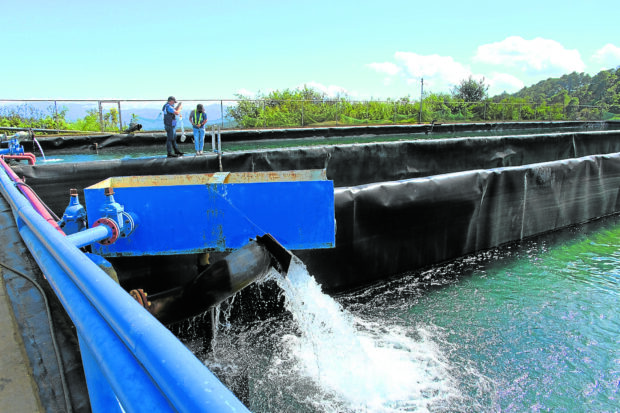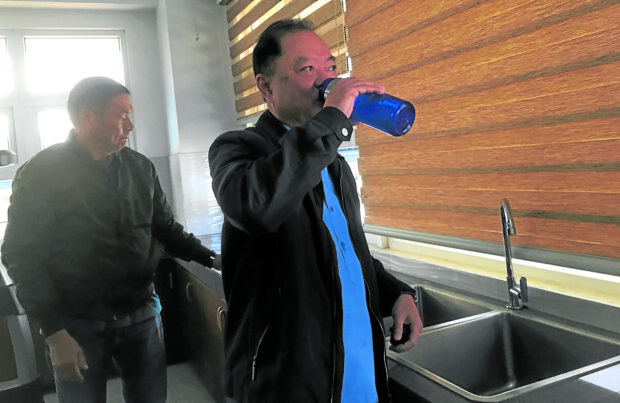
PREPARATIONS | The Baguio Water District has been cleaning up the Santo Tomas rain basin, the city’s largest rainwater reservoir, in preparation for El Niño. A government team last week gathered samples from the rain basin as part of an investigation of the quality of Baguio’s water sources to determine what triggered the recent outbreak of gastroenteritis and diarrhea. (Photo by NEIL CLARK ONGCHANGCO
BAGUIO CITY, Benguet, Philippines — The city’s water utility is campaigning to restore public trust in the city’s drinking water, given the future difficulties that are likely to happen because of this year’s El Niño phenomenon.
Salvador Royeca, general manager of the Baguio Water District (BWD), and the utility’s officials and employees, drank straight from the tap at the start of the week to dispel any apprehension concerning the potability of chlorinated water that is piped into local households.
He again drank tap water at a Wednesday briefing where he assured the public that Baguio water is safe amid the surge of stomach flu, diarrhea and acute gastroenteritis (inflamed digestive system) that prompted Mayor Benjamin Magalong to declare an outbreak on Jan. 10.
The ailments are associated with dirty or contaminated water or poorly cooked meals.
Nine likely sources of the contamination that tested positive for coliform have been ordered to cease operating to allow further testing and cleanup, including water delivery services with their own private deep wells and some food establishments.
But BWD deep wells and waterlines serving downtown Baguio were cleared of contamination based on a Jan. 9 microbacterial laboratory examination.
Other samples taken from different Baguio water sources were transmitted to the Research Institute for Tropical Medicine and results were expected to be released on late Wednesday.
Among the areas sampled by the City Health Services Office (CHSO) and the Department of Health was the Santo Tomas rain basin, the city’s biggest rainwater harvesting reservoir which can contain up to 70,000 cubic meters of water.
READ: Baguio City probing rising cases of gastroenteritis linked to dirty water

STRAIGHT FROM THE TAP | Baguio Water District general manager Salvador Royeca drinks from the tap to prove that the city’s water supply is safe. (Photo by VINCENT CABREZA / PRC)
Contained
The spike in cases of diarrhea has since been contained, according to Dr. Celia Flor Brillantes in a report she gave the city council on Jan. 15. She said the city government’s primary task was to identify the source of tainted water so the outbreak would officially be declared over.
In an earlier briefing on Sunday, Magalong also stressed that BWD water was safe, provided it would be discharged from clean pipes and not from secondary containers, like water tanks.
But the city government continues to advise residents to consume purified water or bottled mineral water until tests clear all open sources, deep wells and other facilities that supply the city.
According to Royeca, tap water serving the city’s 128 barangays comes from a three-grid system that uses more than 60 deep wells, open sources like spring water, the rain basin built by the American colonial government for Baguio, and three more recently completed rain harvesting reservoirs in Baguio’s Busol Watershed (with a combined capacity of over 50,000 cu. m.).
Chlorine residue
“Since each group of barangays has its own deep wells, it would be impossible if all three [grid] areas were simultaneously polluted,” he said. Clusters of infected patients identified by the CHSO live in more than 20 separate barangays.
Before water is discharged through the pipes, it undergoes extensive chemical and chlorination treatments, including a UV (ultraviolet radiation) facility that disinfects the water of any microorganisms or microsolids, Royeca said. Each day, water undergoes tests for chlorine residue.
“Zero residue makes us panic because the residue assures us that water remains sanitized,” he said.
The Philippine Standard for Drinking Water also requires the BWD to conduct monthly and annual chemical and bacteriological analyses of water consumed in Baguio, he said. Open sources like the rain basin undergo a more thorough sanitation process to remove sedimentation and potential pesticide residue from vegetable gardens and settlements surrounding the reservoir, Royeca said.
He said the outbreak should not distract people from a bigger problem posed by El Niño and overpopulation. the BWD supplies an average of 44,607.43 cu. m. of treated and chlorinated water each day—and as much as 60,000 cu.m. during peak tourist season.
The volume of water is sufficient for the city’s more than 360,000 residents but the BWD resorts to “supply balancing” or water rationing once resources are taxed by too many transients and tourists, Royeca said.
To prepare for El Niño, the BWD will undertake a water conservation campaign while completing a major repiping project after projecting that some BWD deep wells may suffer low pressure conditions because of low rainfall volume.

